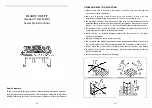
4
2.2.3
To a fireplace that has a precast concrete or clay flue
block system conforming to BS1289. The appliance
is suitable for installations conforming to older
versions of BS1289 as well as the current edition.
The flue blocks must have a minimum width not
less than 63mm and a cross-sectional area not less
than 13,000mm
2
.
Older editions of BS1289 required
a cross-sectional area of 13,000mm
2
. The current
revision of the standard requires 16,500mm
2
. This
appliance is suitable in both cases. The total depth of
the opening measured from the finished front of the
fireplace (Including plaster, surround etc) must be
not less than 100mm.
The current version of BS1289 recommends that
there should be an air space or insulation between
the flue blocks and the plaster because heat transfer
may cause cracking on directly plastered flues.
However, generally this appliance is suitable for
installations under all circumstances unless there is a
history of cracking problems.
Remember that faults such as cracking may be
caused by poorly built and restrictive flues, e.g.
mortar extrusions, too many bends, flue heights
below three metres, restrictive terminations, etc.
2.2.4
To a builder’s opening within the dimensions shown
in figure 1a.
2.3
Suitable flues and minimum flue sizes are as
follows:-
a. 225mm x 225mm conventional brick flue.
b. 175mm diameter lined brick or stone flue.
c. 200mm diameter factory made insulated flue
manufactured to BS 4543.
d. 175mm diameter flue pipe (see B.S 6461 part 1
for suitable materials).
e.
Single wall, twin wall or flexible flue liner of
minimum diameter 125mm. The materials to be
used are stainless steel or aluminium as specified
in B.S 715. It should be noted that, sharp bends
or horizontal runs in metal flues at the top of the
system can be a cause of problems in these types
of installation.
f.
A properly constructed precast concrete or clay
flue system conforming to BS 1289 Part 1 or 2.
2.4
The minimum effective height of the flue must be
3m.
2.5
The flue must not be used for any other appliance or
application.
2.6
Any chimney dampers or restrictors should be
removed. If removal is not possible they must be
fixed in the open position.
2.7
If the appliance is intended to be installed to a
chimney which was previously used for solid fuel,
the flue must be swept clean prior to installation. All
flues should be inspected for soundness and freedom
from blockages.
2.8
If the fireplace opening is of underfloor draught
type, it must be sealed to stop any draughts.
2.9
The appliance must be mounted behind a non-
combustible hearth (n.b conglomerate marble
hearths are considered as non-combustible). The
appliance can be fitted to a purpose made proprietary
class “O” 150°C surround. The hearth material
must be at least 12mm thick. The periphery of the
hearth (or fender) should be at least 50mm above
floor level to discourage the placing of carpets or
rugs over it.
The surface of the hearth must be sufficiently flat to
enable the bottom of the front surround, the burner
bracket and the bottom front cover casting to be
aligned horizontally. Any excessive unevenness
(uneven tiles, Cotswold stone, etc.) should be
rectified.
The appliance must not stand on combustible
materials or carpets.
The appliance must not be fitted directly
against a combustible wall.
If the appliance is to
be fitted against a wall with combustible cladding,
the cladding must be removed from the area covered
by the outer surround
(see figure 1c). We suggest
that the actual surround is used as a template to
mark the area for combustible cladding removal.
2.10
The minimum allowable distance to a corner wall
from the outside edge at either side of the front
surround is 178mm.
2.11
The front face of the fireplace should be reasonably
flat over the area covered by the convection box top
and side flange seals to ensure good sealing. These
faces should be made good if necessary.
The fireplace floor should be reasonably flat to
ensure that a good seal with the convection box can
be made (see fig.15).
2.12
The minimum height from the top surface of the
hearth to the underside of any shelf made from
wood or other combustible materials is as follows:-
•
For a shelf up to 150mm deep
Minimum height = 750mm.
•
For a shelf deeper than 150mm
Minimum height = 750mm + 12.5mm for every
25mm depth over 150mm.
2.13
Note that soft wall coverings (e.g. embossed vinyl,
etc.) are easily affected by heat. They may scorch or
become discoloured when close to a heating
appliance. Please bear this in mind when installing.
2.14
The appliance must not be installed in any room
which contains a bath or shower or where steam is
regularly present
.
2.15
An extractor fan may only be used in the same room
as this appliance, or in any area from which
ventilation for the appliance is taken, if it does not
affect the safe performance of the appliance. Note
the spillage test requirements detailed further on in
this manual. If the fan is likely to affect the appliance,
the appliance must not be installed unless the fan is
permanently disconnected.
2.16
I
n the United Kingdom (GB)
no special ventilation
bricks or vents are required in the room for this
appliance
.
In the Republic of Ireland (IE), permanent
ventilation must comply with the regulations
currently in force.
2.17
Propane gas appliances must not be installed in a
room which is built entirely below ground level (see
BS 5871 Part 2).





































